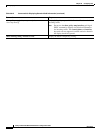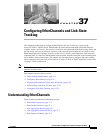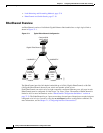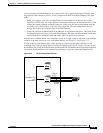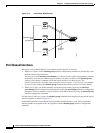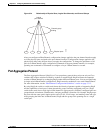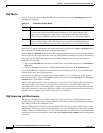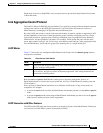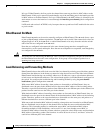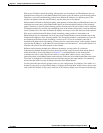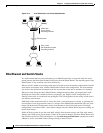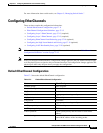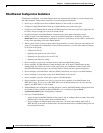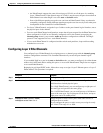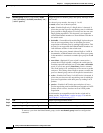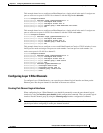
37-8
Catalyst 3750-E and 3560-E Switch Software Configuration Guide
OL-9775-02
Chapter 37 Configuring EtherChannels and Link-State Tracking
Understanding EtherChannels
In Layer 2 EtherChannels, the first port in the channel that comes up provides its MAC address to the
EtherChannel. If this port is removed from the bundle, one of the remaining ports in the bundle provides
its MAC address to the EtherChannel. For Layer 3 EtherChannels, the MAC address is allocated by the
stack master as soon as the interface is created through the interface port-channel global configuration
command.
LACP sends and receives LACP PDUs only from ports that are up and have LACP enabled for the active
or passive mode.
EtherChannel On Mode
EtherChannel on mode can be used to manually configure an EtherChannel. The on mode forces a port
to join an EtherChannel without negotiations. The on mode can be useful if the remote device does not
support PAgP or LACP. In the on mode, a usable EtherChannel exists only when the switches at both
ends of the link are configured in the on mode.
Ports that are configured in the on mode in the same channel group must have compatible port
characteristics, such as speed and duplex. Ports that are not compatible are suspended, even though they
are configured in the on mode.
Caution You should use care when using the on mode. This is a manual configuration, and ports on both ends of
the EtherChannel must have the same configuration. If the group is misconfigured, packet loss or
spanning-tree loops can occur.
Load-Balancing and Forwarding Methods
EtherChannel balances the traffic load across the links in a channel by reducing part of the binary pattern
formed from the addresses in the frame to a numerical value that selects one of the links in the channel.
EtherChannel load-balancing can use MAC addresses or IP addresses, source or destination addresses,
or both source and destination addresses. The selected mode applies to all EtherChannels configured on
the switch. You configure the load-balancing and forwarding method by using the port-channel
load-balance global configuration command.
With source-MAC address forwarding, when packets are forwarded to an EtherChannel, they are
distributed across the ports in the channel based on the source-MAC address of the incoming packet.
Therefore, to provide load-balancing, packets from different hosts use different ports in the channel, but
packets from the same host use the same port in the channel.
With destination-MAC address forwarding, when packets are forwarded to an EtherChannel, they are
distributed across the ports in the channel based on the destination host’s MAC address of the incoming
packet. Therefore, packets to the same destination are forwarded over the same port, and packets to a
different destination are sent on a different port in the channel.
With source-and-destination MAC address forwarding, when packets are forwarded to an EtherChannel,
they are distributed across the ports in the channel based on both the source and destination MAC
addresses. This forwarding method, a combination source-MAC and destination-MAC address
forwarding methods of load distribution, can be used if it is not clear whether source-MAC or
destination-MAC address forwarding is better suited on a particular switch. With source-and-destination
MAC-address forwarding, packets sent from host A to host B, host A to host C, and host C to host B
could all use different ports in the channel.



